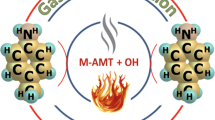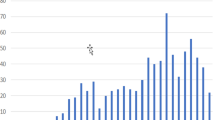Abstract
The free-radical nitric oxide is now considered to play an important role in mammalian physiology and pathology. Enzymatic studies have shown that nitric oxide biosynthesis is initiated by an NADPH-dependentN-hydroxlation ofl-arginine, formingN ω-hydroxy-l-arginine as an intermediate. However, the subsequent enzymatic steps that generate nitric oxide fromN ω-hydroxy-l-arginine are unknown. We have used ab initio quantum chemical calculations to investigate a mechanism that forms nitric oxide fromN-hydroxyguanidine, used as a model forN ω-hydroxy-l-arginine. Our calculations indicate that mechanisms of nitric oxide formation involving nucleophilic attack by hydroperoxy anion at theN-hydroxyguanidine carbon are energetically feasible.
Similar content being viewed by others
References
Green, L. C.; De Luzuriage, K. R.; Wagner, D. A.; Rand, W.; Istfan, N.; Young, N.; Young, V. R.; Tannenbaum, S. R.Proc. Natl. Acad. Sci. U.S.A. 1981,78, 7764.
Ignarro, L.J. Ann. Rev. Pharmacol. Toxicol. 1990,30, 535.
Moncada, S.; Palmer, R. M. J.; Higgs, E. A.Biochem. Pharmacol. 1989,38, 1709.
Hibbs, J. B.; Taintor, R. R.; Vavrin, Z.; Granger, D. L.; Drapier, J. C.; Amber, I. J.; Lancaster, J. R. InNitric Oxide from L-Arginine: A Bioregulatory System; Mocada, S.; Higgs, E. A., Eds.; Elsevier: New York, 1990; pp 189–223.
Stuehr, D. J.; Griffith, O. W.Adv. Enzymol. 1992,65, 287.
Gibbs, J. B.; Taintor, R. R.; Vavrin, Z.; Rachlin, E. M.Biochem. Biophys. Res. Commun. 1988,157, 87.
Stuehr, D. J.; Nathan, C. F.J. Exp. Med. 1989,169, 1543.
Lepoivre, M.; Chenais, B.; Yapo, A.; Lemaire, G.; Thelander, L.; Tenu, J. P.J. Biol. Chem. 1990,265, 14143.
Curran, R. D.; Ferrari, F. K.; Kispert, P. H.; Stadler, J.; Stuehr, D. J.; Simmons, R. L.; Billiar, T. R.FASEB J. 1991,5(7), 2085.
Aisaka, K.; Gross, S. S.; Griffith, O. W.; Levi, R.Biochem. Biophys. Res. Commun. 1989,163, 710.
Rees, D. D.; Palmer, R. M. J.; Moncada, S.Proc. Natl. Acad. Sci. U.S.A. 1989,87, 3375.
Kilbourn, R. G.; Gross, S. S.; Jubran, A.; Adams, J.; Griffith, O. W.; Levi, R.; Lodato, R. F.Proc. Natl. Acad. Sci. U.S.A. 1990,87, 3629.
Radomski, M. W.; Palmer, R. M. J.; Moncada, S.Proc. Natl. Acad. Sci. U.S.A. 1990,87, 5183.
Garthwaite, J.; Charles, S. L.; Chess-Williams, R.Nature 1988,336, 385.
Bredt, D. S.; Snyder, S. H.Proc. Natl. Acad. Sci. U.S.A. 1990,87, 682.
Forsterman, U.; Pollock, J. S.; Schmidt, H. H. H. W.; Heller, M.; Murad, F.Proc. Natl. Acad. Sci. U.S.A. 1991,88(5), 1788.
Kwon, N.S.; Nathan, C. F.; Stuehr, D. J.J. Biol. Chem. 1989,264, 20496.
Tayeh, M. A.; Marietta, M. A.J. Biol. Chem. 1989,264, 19654.
Kwon, N. S.; Nathan, C. F.; Gilker, C.; Griffith, O. W.; Matthews, D. E.; Stuehr, D. J.J. Biol. Chem. 1990,265, 13442.
Palmer, R. M. J.; Rees, D. D.; Ashton, D. S.; Moncada, S.Biochem. Biophys. Res. Comm. 1988,153, 1251.
Palmer, R. M. J.; Ashton, D. S.; Moncada, S.Nature 1986,333, 664.
Stuehr, D. J.; Kwoon, N. S.; Nathan, C. F.; Griffith, O. W.; Feldman, P. L.; Wiseman, J.J. Biol. Chem. 1991,266(10), 6259.
Herzig, L., Massa, L. J., Santoro, A., Sapse, A. M.J. Org. Chem. 1981,46, 2330.
Sapse, A. M.; Herzig, L.; Snyder, G.Cancer Res. 1981,41, 1824.
Frisch, M. J.; Binkley, J. S.; Schlegel, H. B.; Raghavachari, K.; Melius, C. F.; Martin, R. L.; Stewart, J. J. P.; Bobrowicz, F. W.; Rohlfing, C. M.; Kahn, L. R.; Defrees, D. J.; Seeger, R.; Whiteside, R. A.; Fox, D. J.; Fleuder, E. M.; Pople, J. A., InGaussian 86; Carnegie-Mellon Quantum Chemistry Publishing Unit; Pittsburgh, PA, 1984.
Dix, T. A.; Kuhn, D. M.; Benkovic, S. J.Biochemistry 1987,26, 3354.
Arroyo, C. M.; Forray, C.; El Fakahany, E. E.; Rosen, G, M.Biochem. Biophys. Res. Comm. 1990,170, 1177.
Stolze, K.; Nohl, H.Free Radical Res. Comm. 1990,8, 123.
Author information
Authors and Affiliations
Rights and permissions
About this article
Cite this article
Stuehr, D.J., Sapse, AM. & Sapse, D.S. An ab initio study of an oxidative mechanism that forms nitric oxide from theN-hydroxyguanidinium ion. Struct Chem 4, 143–147 (1993). https://doi.org/10.1007/BF00679340
Received:
Revised:
Accepted:
Issue Date:
DOI: https://doi.org/10.1007/BF00679340




